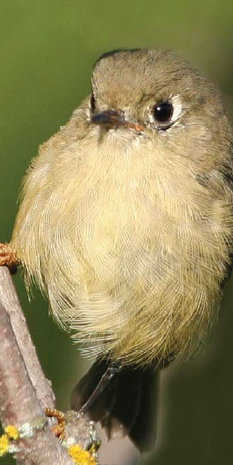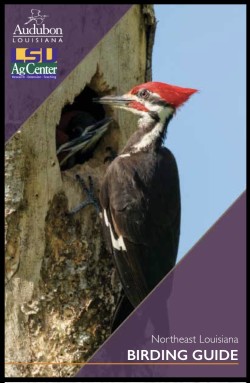Northeast Louisiana Birding Guide
Northeastern Louisiana offers some of the most unknown and exciting birding and wildlife viewing opportunities in the country. Audubon Louisiana, LSU AgCenter and Louisiana Delta Adventures have published a Northeast Louisiana Birding Guide, poster and interactive map for your use.
Louisiana Bayou Bluebird Society

America’s Wetland Mississippi River Birding Trail

Public Lands with Birding Opportunities
Bayou Macon Wildlife Management Area
Bayou Macon Wildlife Management Area is located in East Carroll Parish approximately 3.5 miles east of Oak Grove and 7.5 miles northwest of Lake Providence. Contains a wildlife viewing trail that is four miles long. LA 2 transects the northern portion of the area. Schrock Road crosses the southern portion.
Russell Sage Wildlife Management Area
Russell Sage Wildlife Management Area located in Morehouse, Ouachita and Richland parishes, approximately 7 miles east of Monroe and 10 miles west of Rayville. Access is provided by US 80 and I-20, which bisect the area. Thirteen waterfowl management units totaling 7,550 acres have been developed. Included are 500 acres of flooded agricultural fields, 4,500 acres of moist soil management units, and 2,550 acres of greentree impoundments. Upgrades and renovations to pumping stations were completed in 2015. These impoundments are heavily utilized by waterfowl as well as shorebirds and wading birds. An observation tower is present which provides for public viewing of waterfowl and wetland birds. Russell Sage is also an excellent location for viewing terrestrial birds and raptors.
Ouachita Wildlife Management Area
Ouachita Wildlife Management Area, 13,331 acres in size, is located in southeast Ouachita Parish, approximately 7 miles southeast of Monroe. It is bordered on the north by the Russell Sage WMA and on the east by Bayou Lafourche. March 2015 this WMA was consolidated with Russell Sage WMA. Thirteen waterfowl management units totaling 7,550 acres have been developed. Included are 500 acres of flooded agricultural fields, 4,500 acres of moist soil management units, and 2,550 acres of greentree impoundments. Upgrades and renovations to pumping stations were completed in 2015. These impoundments are heavily utilized by waterfowl as well as shorebirds and wading birds. An observation tower is present which provides for public viewing of waterfowl and wetland birds. Russell Sage is also an excellent location for viewing terrestrial birds and raptors.
Floy Ward McElroy Wildlife Management Area
Floy Ward McElroy Wildlife Management Area is located in Richland Parish, two miles north of Rayville, public access is by US 425/Hwy 137. This wetland is providing habitat for wood ducks, wintering waterfowl, wading birds, shore birds, alligators, and wetland mammals. An observation platform has been constructed overlooking the lake.
Big Lake Wildlife Management Area
Big Lake Wildlife Management Area is located in Franklin, Madison, and Tensas parishes, 12 miles east of Gilbert. Big Lake WMA is comprised of approximately 19,231 acres, including seven small lakes with the largest approximately 160 acres in size. Major access routes to the area are LA 4 and LA 610. Big Lake WMA is visited by many neo-tropical bird species annually and home to large numbers of passerine birds. This area is recognized by the American Bird Conservancy as an important site. Bald eagles and osprey are observed regularly.
Boeuf Wildlife Management Area
Boeuf Wildlife Management Area is located in Caldwell and Catahoula parishes, 10 miles southeast of Columbia. Major routes to the area are LA 4, LA 559, LA 133 and LA 848. Major routes to the area are LA 4, LA 559, LA 133 and LA 848. Parish roads provide access to the interior from the north, south, and west, with Boeuf River providing boat access along the eastern boundary. Bald Eagles are observed frequently on this area and nesting is documented in the surrounding area. Boeuf WMA is visited by many neo-tropical and shorebird bird species annually and home to large numbers of passerine and wading birds. The areas managed for waterfowl, wading birds, and shorebirds along with the numerous sloughs and waterways offer excellent waterfowl hunting and viewing opportunity.
Buckhorn Wildlife Management Area
Buckhorn Wildlife Management Area is located in Tensas Parish, 14 miles west of St. Joseph. The area is comprised of 11,262 acres situated in the Mississippi River alluvial flood plain. Buckhorn WMA is visited by many neo-tropical and shorebird bird species annually and home to large numbers of passerine and wading birds. The areas managed for waterfowl, wading birds, and shorebirds along with the sloughs and waterways offer excellent waterfowl hunting and viewing opportunity. The American Bird Conservancy has recognized Buckhorn WMA in its Important Birding Areas Program.
Dewey W. Wills Wildlife Management Area
Dewey W. Wills Wildlife Management Area consists of 63,423 acres located approximately 20 miles northeast of Alexandria and along the south shore of Catahoula Lake south to Larto Lake. The major highway crossing through the area is LA 28. Neo-tropical nesters, shorebirds, wading birds, and various raptors are among the birds that can be found on the WMA.
Sicily Island Hills Wildlife Management Area
Sicily Island Hills Wildlife Management Area is located in northeast Catahoula Parish, 6 miles west of Sicily Island, Louisiana. Major routes to the area are LA 8 and LA 915. Bald Eagles are observed frequently on this area and nesting is documented in the surrounding area. Sicily Island Hills WMA is visited by many neo-tropical bird species annually and home to large numbers of passerine birds.
Bayou Cocodrie National Wildlife Refuge
Bayou Cocodrie National Wildlife Refuge is located near Ferriday, there are two maintained trails available for hiking and wildlife observations year round. The Cypress Creek Boardwalk Trail begins outside the gates of the refuge office and the Observation Tower Trail is located along the Boat Ramp Road. there are over 13 miles of primitive trails throughout the refuge open for wildlife viewing when hunting season is closed.
Black Bayou Lake National Wildlife Refuge
Black Bayou Lake National Wildlife Refuge is located just minutes from Monroe, this 4,500-acre refuge has a nature trail, wildlife pier, raised observation deck and photo blind. The refuge provides valuable habitat for migratory waterfowl and neotropical migratory songbirds.
D’arbonne National Wildlife Refuge
D’Arbonne National Wildlife Refuge located north of West Monroe, Louisiana, lies on the western edge of the Mississippi Alluvial Valley. It was established in 1975 to protect bottomland hardwoods and provide wintering habitat for migratory waterfowl. This refuge offers foot trails, wildlife observation, observation tower, scenic vistas (land and water), hunting, fishing, photography and group tours.
Handy Brake National Wildlife Refuge
HandyBrake National Wildlife Refuge is located just north of Bastrop in Morehouse Parish, north central Louisiana. The refuge was established in 1988 with the southeast’s first fee title transfer of a Farmer’s Home Administration tract (466 acres) to the U.S. Fish and Wildlife Service. A free lease of 38 acres from International Paper Company increased the refuge to the current 501 acres. An observation platform overlooks a permanent wetland, which is excellent habitat for wintering waterfowl, wading birds and many other wetland dependent species. Birding, wildlife observation and photography are possible at the refuge.
Tensas River National Wildlife Refuge
Tensas River National Wildlife Refuge is a refuge of bottomland forest and encompasses nearly 80,000 acres of bottomland hardwood forest and is home to over 400 different species of wildlife. The last sighting of the ivory-billed woodpecker, which is thought to be extinct by most scientists, occurred in the 1940’s adjacent to what is now the Tensas River National Wildlife Refuge.
Upper Ouachita National Wildlife Refuge
Upper Ouachita National Wildlife Refuge consists of 49,948 acres located in Union and Ouachita Parishes. The legislative purposes for the refuge are to conserve wetlands and manage for migratory birds. The refuge is bisected by the scenic Ouachita River and consists of upland pine-hardwood and bottomland hardwood forest; agriculture, moist-soil wetlands, and open water. Upper Ouachita NWR provides excellent wintering habitat for tens of thousands of ducks and geese.


